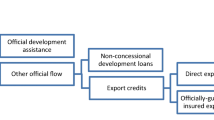Abstract
Development planning constituted the main focus of economic policy making in Turkey from the 1960s until the mid-1970s. The external resource requirements of the plans were financed essentially through state-to-state loans or project credits from other governments or supranational institutions. Domestically, the financial structure involved the allocation of credit and foreign exchange according to the priorities of the plans. In this setting, finance is repressed in the sense of Shaw-McKinnon—that is, the allocation of financial resources is based on nonprice criteria, so that the prices, usually implying negative or insignificant yields for financial assets, are not indicative of the true scarcity of financial resources. Moreover, the financial-repression hypothesis implied that because finance was repressed, financial resources would be scarce. The idea of financial repression rested on the belief that repressed finance and planning, on the one hand, and liberal finance and allocation of resources through the market, on the other, form two mutually exclusive resource allocation mechanisms. Thus, financial reform has almost invariably been implemented as part of a wider project involving a market-oriented structural adjustment program. In the market-oriented scheme, the economy is to borrow from international financial markets through the mediation of domestic financial institutions, and domestic credit allocation is to be based on price criteria. The expectation (and this was the aspect most emphasized by the early literature) was that as a result of market-determined prices that fully reflect the scarcity of resources, savings and investment would increase both in quality and quantity, thereby enhancing the sustainable-growth prospects of the reforming economies.
Access this chapter
Tax calculation will be finalised at checkout
Purchases are for personal use only
Preview
Unable to display preview. Download preview PDF.
Similar content being viewed by others
References
Akyüz, Y. (1993). “Financial Liberalization: The Key Issues.” In Y. Akyüz and G. Held (eds.), Finance and the Real Economy: Issues and Case Studies in Developing Countries (pp. 19–68). Santiago: United Nations Conference on Trade and Development.
Altay, Ö. (1987). “Foreign Exchange Position Management of Commercial Banks.” Central Bank Economic Research Bulletin (June): 53–63 (in Turkish).
Altinkemer, M., and N.K. Ekinci. (1992). “Capital Account Liberalization: The Case of Turkey.” New Perspectives on Turkey 4: 89–108.
Atiyas, I. (1990). “The Private Sector’s Response to Financial Liberalization in Turkey: 1980–1982.” In T. Ancanlı and D. Rodrik (eds.), The Political Economy of Turkey: Debt, Adjustment and Sustainability. London: Mcmillan Pr
Atiyas, I., and H. Ersel. (1994). “The Impact of Financial Reform: The Turkish Experience.” In G. Caprio, I. Atiyas, and A.J. Hanson (eds.), Financial Reform: Theory and Experience. London: Cambridge University Press.
Baysan, T., and C. Blitzer. (1990). “Turkey’s Trade Liberalization in the 1980’s and Prospects for its Sustainability.” In T. Ancanh and D. Rodrik (eds.), The Political Economy of Turkey: Debt, Adjustment and Sustainability. London: Mcmillan Press.
Celasun, M., and D. Rodrik. (1989). “Debt, Adjustment and Growth: Turkey.” In J.D. Sachs and S.M. Collins (eds.), Developing Country Debt and Economic Performance. NBER Country Studies: Volume 3. Chicago: University of Chicago Press.
Collier, P., and C. Mayer (eds.). (1989). Finance and Economic Development. Special issue of Oxford Review of Economic Policy 5(4).
Ekinci, N.K. (1990). “Macroeconomic Developments in Turkey: 1980-1988.” METU Studies in Development 17: 73–115.
Ersel, H., and L. İskenderoğfu. (1993). “Monetary Programming in Turkey.” In Y. Aşıkoğlu and H. Ersel (eds.), Financial Liberalization in Turkey. Ankara: Central Bank of The Republic of Turkey.
Fischer, B., and H. Reisen. (1993). Liberalising Capital Flows in Developing Countries: Pitfalls, Prerequisites and Perspectives. Paris: OECD.
Fry, M.J. (1989). “Financial Development: Theories and Recent Experience.” In P. Collier and C. Mayer (eds.), Finance and Economic Development. Special issue of Oxford Review of Economic Policy 5(4): 13–28.
Gibson, H.D., and E. Tsakalotos. (1994). “The Scope and Limit of Financial Liberalisation in Developing Countries: A Critical Survey.” Journal of Development Studies 30: 578–628.
Grabel, I. (1995). “Speculation-led Economic Development: A Post-Keynesian Interpretation of Financial Liberalization Programmes in the Third World.” International Review of Applied Economics 9(2): 127–149.
McKinnon, R.I. (1989). “Financial Liberalization and Economic Development: A Reassessment of Interest Rate Policies in Asia and Latin America.” In P. Collier and C. Mayer (eds.), Finance and Economic Development. Special issue of Oxford Review of Economic Policy 5(4): 29–53.
Minsky, H. (1982). Can It Happen Again? New York: Sharpe.
Montiel, P.J. (1994). “Capital Mobility in Developing Countries: Some Measurement Issues and Empirical Results.” World Bank Economic Review 8: 311–350.
Stiglitz, J.E. (1993). “The Role of the State in Financial Markets.” In Proceedings of the World Bank Annual Conference on Development Economics 1993. Supplement to World Bank Economic Review and World Bank Research Observer.
UNCTAD. (1991). Trade and Development Report. New York: United Nations Publications.
Editor information
Editors and Affiliations
Rights and permissions
Copyright information
© 1997 Springer Science+Business Media New York
About this chapter
Cite this chapter
Ekinci, N.K. (1997). Financial Liberalization Under External Debt Constraints. In: Gupta, K.L. (eds) Experiences with Financial Liberalization. Recent Economic Thought Series, vol 52. Springer, Dordrecht. https://doi.org/10.1007/978-94-011-5370-6_10
Download citation
DOI: https://doi.org/10.1007/978-94-011-5370-6_10
Publisher Name: Springer, Dordrecht
Print ISBN: 978-94-010-6257-2
Online ISBN: 978-94-011-5370-6
eBook Packages: Springer Book Archive




